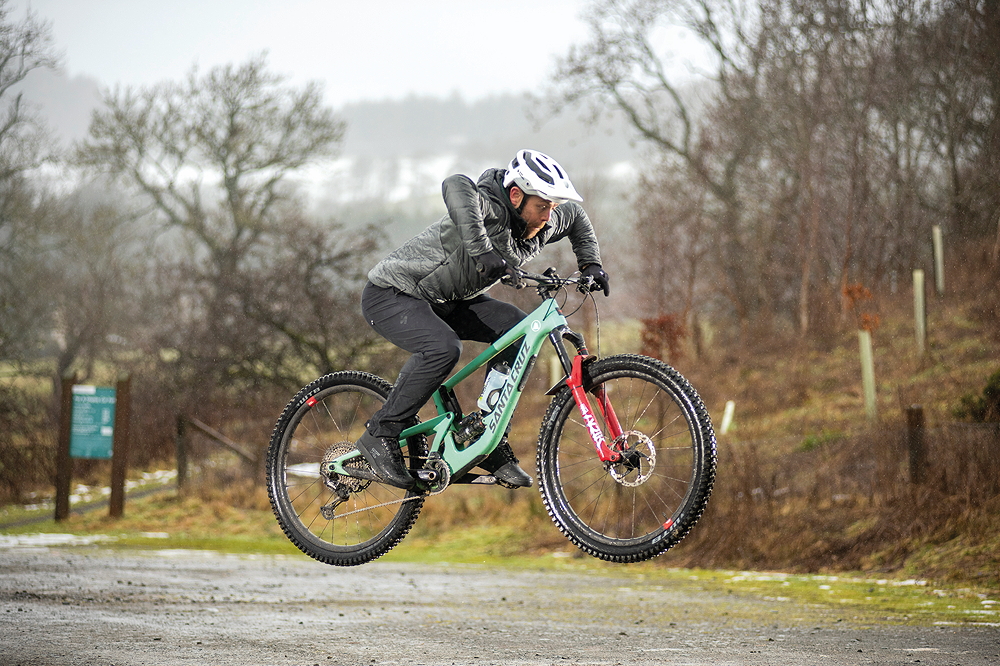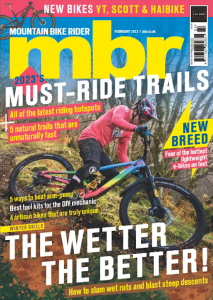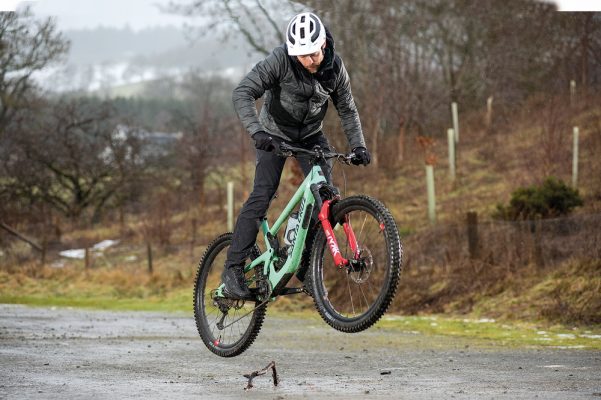This time we sharpen up the Swiss Army Knife of mountain bike manoeuvres. It’s not how high you can hop but how you’re getting off the ground that really counts.
Learning how to bunny hop and quickly create lift will allow you to smooth out trails by using obstacles to your advantage, as well as impressing mates.
Read more: Best mountain bike 2021, all you need to know
It’s always a good time to look in depth at two of the most fundamental and crucial skills a mountain biker can master: the bunny-hop and the manual. If you’re missing your bike and you would like to return to the trails as a better rider at some point this year, then read on.
First up, the bunny-hop. Once mastered, this skill will allow you to determine where you apply weight to the trail. It will mean that you can decide where to go heavy and light, and ultimately it will allow you to control your traction when it all gets a bit stressful. Contrary to what most people think though, it’s not about how high you can get your wheels off the ground, but how you get your wheels off the ground in the first place. Confused? Read on.

Having your go-to stance on the bike dialled is just as important as how you set your bike up or what lines you take.
Lock in
In order to really trust your technique here you’re going to have to do a few things that allow you to feel confident and attached to your bike. Read on and see how many of the following you already do without even realising.
Foot position
In order to be able to tackle a bunny hop with confidence, you’ll need to trust that your feet will remain on the pedals. To learn this properly, and ensure that you’re not cheating by just pulling on your clips, flat pedals are the best choice for this. A good pair of mountain bike shoes will have a sole specifically designed for sticking to the pins, and they will be supportive enough that you won’t feel your foot collapsing around the shape of the pedal. Try and position your foot so that you can feel the ball of your big toe resting up against the leading row of pins. All of your toes should be hanging off the front of the pedal.
Ankle flexibility
When it comes to moving your weight around in order to start bunny-hopping, flexing your ankle joints as part of your leg push will help you stay attached to the pedals. Generally we tell people to drop their heels when they are riding, but when you’re bunny- hopping you want your bike to come with you, so hooking your toes around the pedal, and driving your trailing foot back, will mean you drive your shoe directly into the pins. This is really no different to how your feet would move if you were just jumping off the ground without your bike. As your feet push off the ground you’d end up on your toes and your feet would be pointed toward the ground. Do same thing on your flat pedals and your feet will stay attached as you and your bike get airborne.
Solid stance
When you stand up on your bike don’t be afraid to put all of your weight directly through your feet. Dropping your heels here will put your centre of gravity even lower, massively improving your control and stability. If you were to draw a line from the centre of one wheel axle to the other, you want as much of your stance to be under that line as possible. This is one of the benefits of larger wheels on a mountain bike, and means that your bottom bracket can be lower than the axles but not necessarily any closer to the ground. Having your weight dropped below your axles, below your BB, and with your heels dropped below your pedal axles, will all contribute to a solid, low platform that you can trust. So drop your heels.

Thumb hook
As well as hooking your feet around your pedals, another thing that will make a difference to how attached you feel to your bike in the air, is pushing your hands forward on the bars. This subtle gesture of hooking your thumbs underneath your grips will jam you into your cockpit. This should mean that you feel secure at a time when you could otherwise seem unattached or exposed.

Getting low will mean you have more room to push, but even when you are at your most extended with your legs, never break that confident riding position with your arms.
The speed hop
A type of hop where both your wheels leave the ground at the same time and stay level in the air. It’s generally used when you are travelling at speed.

X – If your feet come off when you use flat pedals, maybe it’s time to focus on staying locked into your control.
Range of motion
Your ‘go to’ attack position should be not only your starting position, but your finishing position as well. You know the score: heels down, legs straight, elbows bent, head up. The reason for this being relevant here is that we want you to notice any deviations. What we mean is that as you drop into your bike to open up motion, your legs will bend and your head and chest will come closer to the bars, but as you drive away from the ground, make sure that you don’t go beyond your attack position. Don’t push all the way with your arms. In other words, even when you are at your maximum push with your legs straight, your elbows should still be bent and your head somewhere above your bars.

Lift-off
The aim here is to put so much deliberate effort into the push away from the ground that you don’t have to lift. Your hop should be as close to 100 per cent push as possible, and other than hooking your feet on the pedals you shouldn’t need to lift the bike up at all.
Travel further
When you quickly move closer to your bike in order to get ready to spring away, pause briefly at the bottom and allow that downward momentum to compress your travel slightly. This will load your suspension, and with all that movement out of the way, all of your power will go into pushing you away from the ground.

The bunny-hop
The term ‘bunny-hop’ really refers to a much more dynamic movement where you lever off your rear wheel and jump your bike through the air in more of an arc. This advanced technique allows riders to clear much bigger obstacles, and can also be used at lower speeds.

A good bunny-hop should feel as though you have time in the air.
Range of motion
A bigger range of motion is required here in order to make your bunny-hops more effective. The first part is basically a manual, as you’re trying to lift your front wheel by quickly shifting your weight away from your front end. As you reach your most rearward range of motion and stop, all of that momentum will be transferred into your bike and your front wheel will go light. Let it hang here for a split second to gauge your tipping point, then go from your hips being behind your saddle to being right up at your stem and bars. This huge range of motion should feel like not only is your body moving up, but that your legs are pushing through your pedals and levering your bike away from the ground by pivoting off your rear wheel.

X – The objective here is to drive away from the ground NOT pull in the air.
Lift-off
In the same way that your speed hop is 100 per cent push away from the ground, the levering or pivoting off your rear wheel should feel the same. You’re not lifting your bike off the ground, or sucking it up in the air. What you’re trying to focus on here is your bum going from behind your saddle to being pushed by your legs up to your stem. Your arms will obviously have to pull on the bars to prevent you falling right off the back, but don’t overdo it.
Two-parter
A good way of thinking of a bunny-hop is to break it into two parts: the manual part, and the hop part. If you’re trying to hop a stick on the ground, try and set your manual part up a little bit further out from your target. Your first part, the manual part, should be smooth and deliberate, giving you time to set up your balance and aim. The second part, your hop, should be explosive and fast. You’re trying to drive away from the ground with power.
Progress your hops

o grab your bike and find a stick. You could end up making more progress than you think.
Side hops
Using the larger bunny-hop technique, roll towards a stick and keep it on your side. As you turn away from it you’ll set up a tip in the direction of the obstacle. Use that lean and go for a big bunny-hop. Instead of hopping away from the ground, you’ll be hopping sideways over the stick. Spot your landing and get ready to steer for balance once both wheels are back on the ground.

Hop on the spot
Instead of doing a track stand to keep your balance when stationary, why not try and hop for balance? Pull both your brakes on so that neither of your wheels can turn and use your speed hop technique to raise your wheels off the ground. Once in the air you can tweak your balance by hopping from side to side. You can even try just hopping only your front wheel or only your rear. With practice you’ll be able to adjust your balance with the tiniest of hops.

Grip points
Every time we run a session on hops we emphasise the importance of pushing away from the ground. This is because in the wider context of trail riding you need to be able to generate traction by making yourself heavy against the ground. The airtime in a speed hop or bunny-hop is a result of driving your weight away from the trail with a powerful push. You’re not trying to avoid obstacles by getting your wheels off the ground. You’re trying to link all the smooth parts of the trail together by being heavy on them and creating traction.
Stay positive
Hopefully this article serves as a step in the right direction and encourages you to go swing your leg over your bike. Remember you can still continue to make progress even under the strictest of lockdown conditions. Just reading this article will have made you think about your technique for 10 minutes, so you’re already in a better place. Next issue we look at the elusive manual.





